Monsters of Faerûn was one of the very early books for D&D 3rd edition and the first monster book after the original Monster Manual. The cover of the book matches the Monster Manual and not the Forgotten Realms Campaign Setting as all other Forgotten Realms books later would. It is also the only book that has the title “Monster Compendium” in it’s name. I assume it was planned to have it as a distinct product line, but all further monster books were 200+ pages hardcovers, unlike this 100 page paperback.
I started with fantasy stuff in 1999, the year before 3rd edition was released, and that start was Baldur’s Gate, the game that made BioWare the giant of Western RPGs that it had been for until recently. (Really not a fan of any of their games since Mass Effect 2, which is the best videogame of all time!) A game that just so happens to be set in the Forgotten Realms, so I had to get this book right when it came out. And even though it’s by far the smallest monster book ever released by WotC, and also just the second they made, I think this one really the best one by a far margine. When I went to get the monster pictures from the old art archive from WotCs website (they are still up, but you’ll only get there through search engines), there was barely amy that I didn’t download. And most of those that I am not going to cover here aren’t boring, but they are either beefed up versions of monsters from the Monster Manual (cloaker lord, greater doppelganger) or I already covered them when I did the 1st edition Fiend Folio (bullywug, fire newt, giant strider, gibberling, quaggoth). Truly wonderful book and almost all of the creatures can be imported to other settings without problem. I think a good dozen of them directly inspired monsters for my own Ancient Lands setting. If this book were Star Wars, it would be The Empire Strikes Back.
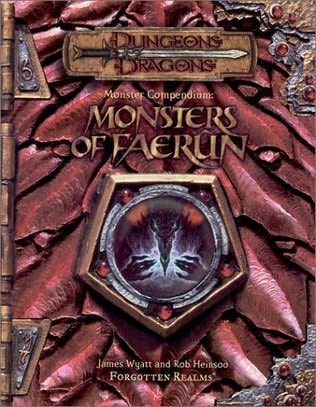
Monster Compendium: Monsters of Faerûn for Dungeons & Dragons 3rd Edition by Wizards of the Coast, 2001; 86 pages of monsters.
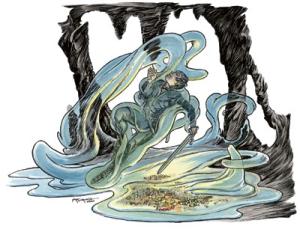
The Aballin is a type of ooze whose most distinguishing trait is that it looks just like water. It also can change between two different states, one being a thick slime, the other a water like liquid that is almost impossible to harm. It is one of the many classic creatures of the type “everything is trying to kill you”, but I think actually one of the less implausible ones. It’s just another slime like all the others, except that it has a clear color. When in its semisolid state, an aballin is quite strong and can slam enemies with considerable force. However its main mode of attack is to engulf its victim and simply drown him.
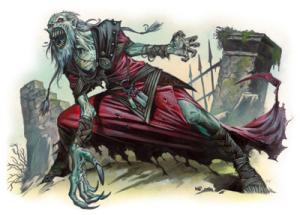
The Banedead is a variant ghoul created by clerics of the evil god Bane. One of their hands is a large claw, which also happens to be the holy symbol of Bane, and also deals 1 point of Dexterity damage. Which is not as measly as it sounds. Since it’s tied to a melee attack, there is no saving throw and there’s a good chance you’re going to encounter them in significant numbers. This can get quite bad over time, especially as banedead are not very strong otherwise and therefore likely to be fought by PCs of low-medium level. Dealing with larger numbers of them over several encounters could make for a very interesting adventure. An interesting detail of the banedead is that they are also created by priests of the Banes son Xvim, which tells us that this book was actually released before the FRCS, as from that point on Xvim is dead and Bane is back! (Variant Ghoul +1)
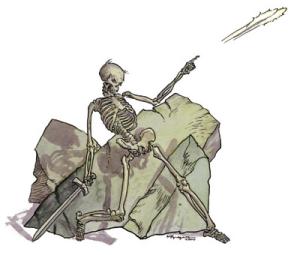
The Baneguard is another undead creature created by the clerics of Bane. It looks like an ordinary skeleton, but is both tougher and far more intelligent. In addition they can shot two magic missiles every three round and use the spell blink every 10 minutes, which makes them randomly fade in and out of the ethereal plane, making it very difficult to hit them. This really is a very simple creature as special abilties go, but the result is something completely different from a normal skeleton. A great example of how you don’t need a full page of stats and 30 spell-like abilities to make an interesting monster. And I think a skeleton that shots magic missiles is really cool.
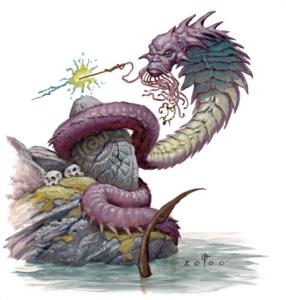
A Banelar is a huge snake monster with a humanlike face, similar to naga. They are extremely intelligent in addition to being of massive size with a Strength and Constitution to match, and they are also always at least 6th level clerics and 6th level wizards. Which makes it absolutely mind-boggling that this is supposed to be a CR 5 creature. To get a human character with comparable stats and abilities, he would have to be 12th level. This looks more like CR 8 or 9 to me. The banelar also gets a +3 bonus on saving throws against petrification. That’s random. The banelar are not demons in the service of the god Bane, but many of them used to be allied with clerics who served him, and now switched their allegiance to followers of Cyric. However, this was while Bane was still dead, and I think they switched back when he returned. They are in some way involved with the internal politics of the Zhentarim, a powerful criminal organization in which the clerics of Bane had a very big influence, and which had a kind of civil war when Bane was killed and his clerics were devided into followers of the new gods Cyric and Xvim. And given that I’ve never seen banelars anywhere else, except as an updated stat block for the D&D 3.5 edition, I suspect very strongly that these are from either a 2nd edition adventure or from a novel. I still think they are quite interesting, being these huge and very smart snakes who are actively involved in the poltics of evil temples and criminal organizations.
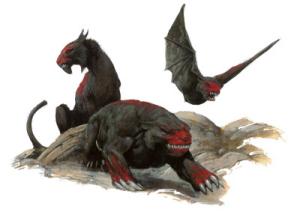
Beasts of Malar are awesome. The illustration alone is enough to make me want to use something like this in my games, and the description and abilities aren’t bad either. Malar is the Faerûnian god of Hunt and Slaughter, and the Beasts of Malar are incarnations of just that. While not terribly big, these things are the ultimate killing machines. Not only arge they extremely strong and tough, they are alost just as intelligent as humans. There is in fact only a single type of beast, but they are shapechangers who can shift between the forms of a big cat, a wolverine, and a bat. They have black fur and always appear to have their faces, paws, and back splattered in blood, and all forms have huge teeth and claws. They can only be hurt by magical weapons, but even then they regenerate almost all wounds very quickly and can only be destroyed with the magic of a priest or druid or blessed weapons. There isn’t really much to them, but I think other than being sized up to Large, I wouldn’t really change aynthing. These are totally mean looking things of blood rage with huge teeth! What more could you want?
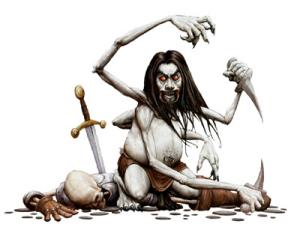
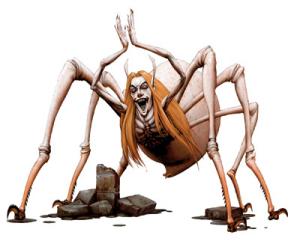
The Chitine is one of my favorite D&D monsters and one of the things that make me see the Forgotten Realms as more than just a “generic fantasy setting”, which it really isn’t. It’s not even “generic D&D”. Chitines are a race of humanoids that are somewhat smaller than humans and have six long arms and insect like eyes and mouths. Other than being trained in using three weapons at once and having an aversion to very bright light, they don’t really have any notable special abilities. While they look savage and live in relatively simple villages deep below the ground, they are actually even smarter than most humans. They don’t have any wizards for some reason, but are lead by the Choldrith, who look even more like spiders and are priestesses of the evil spider goddess Lolth. The chitines are said to have been originally created by the drow as slaves, but even though the two races serve the same deity, they have a deep hatred and hostility for each other and are mortal enemies. They have been around in D&D for much longer than 3rd edition, but I’ve never actually seen them appear in any sourcebooks or adventures for 2nd edition, while they had plenty, if admitedly minor appearances in 3rd edition. I am not quite sure what I find so compelling about them, but I think part of it is the idea of having a humanoid race of similar size and abilities to human, which at the same time is also highly inhuman.
The Chosen One is essentially a ghoul who causes temporary Constitution damage instead of paralysis. It doesn’t say why it is named that way, and only that chosen ones are made by the Red Wizards of Thay as servants. Very weak entry. (Variant Ghoul +1)
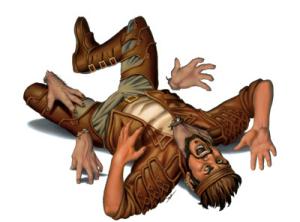
Crawling Claws, on the other hand, are awesome. They also are the other hand, as they are created only from left hands taken from dead or even living humanoids. They don’t have any special abilities or fancyful backstory. They are just animated hands that crawl around and attack people, which is cool and fun enough by itself. Creating one is only a 3rd level spell and each claw is automatically under the command of its creator. For some reason the spell is also evil, even though nothing about it indicates why. Ah well, alignment! Never made any sense, never will.
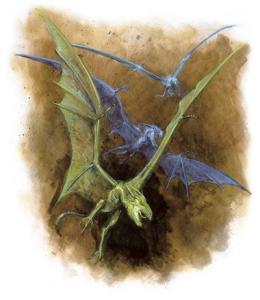
I am not sure where the idea of monsters being the creation of crazy wizards comes from, but it might very well have been Forgotten Realms. Darkenbeasts are somewhat reptilian and bat like monsters created from ordinary small animals by the Red Wizards. As their name hints at, darkenbeasts can not tollerate sunlight and after each ten minutes of exposure there is a 25% chance that the magic will end and the monster return back into an animal. In addition to being winged servants with a high resistance to magic, a wizard can also use a darkenbeast to store a spell for later. When the darkenbeast is near its master, he can retrieve the spell and aim it at whatever target he pleases, which destroyes the darkenbeast in the process. I think these are cooler than winged monkeys.
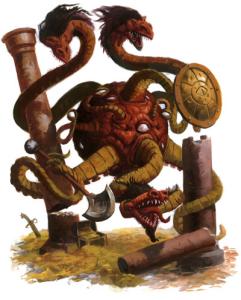
The Deepspawn had the potential to be one of the truly iconic weird monsters of Dungeons & Dragons, but somehow it remained limited to Forgotten Realms and didn’t really make any appearance after 2nd edtition. It’s on the cover of Lost Empires of Faerûn, but I think that’s it. When I first got into D&D with the Forgotten Realms campaign setting box (the 3rd edition FRCS had not been released yet), I thought that this creature was the fourth member of the exclusive group of aboleths, beholders, and illithids. But no it’s not, which is a shame. The deepspawn is a monster with a large spherical body over 5 meters in diameter and has six long tentacles. Three of the tentacles are used as arms, while the other three end in large maws full of sharp teeth. Its eyes are all over the body. The deepspawn by itself is not a terribly dangerous fighter and has only little magic abilities that would make any difference in a fight, but is completely immune to any poison and has a high resistance to magic. Its main ability is to spawn copies of any kind of living creature it has eaten, which takes between 1 and 4 day for each spawn. As a result, a deepspawn is never encountered alone but always surrounded and protected by a considerable force of other monsters it created. While the spawning ability is a bit dubious to me, I really do like its appearance and the idea that something like that would be the mastermind of a dungeon that rules over all the lesser monsters. The deepspawn got updated in Lost Empires of Faerûn, since the stats here are pretty shoddy. Size got increased from Large to Huge (which for a 5 meter sphere with long tentacles seems more correct), Strength got increased from measly 19 to 29 and Charisma bumped up from 4 to 10, which makes much more sense for something with Intelligence and Wisdom of 17. Now that looks a lot meaner, like something of this appearance should.
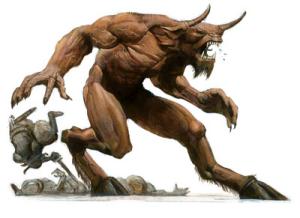
As demons go, the Ghour doesn’t seem particularly exciting or noteworthy. It’s a big creature that looks like an oversized hybrid of a minotaur and an ogre and has all the abilities of regular D&D demons. But it’s its description and context that make it shine. Ghours are most commonly found as servants of the demon lord Baphomet, who is mostly worshipped by ogres, giants, minotaurs, and the like. What makes them interesting is that these demons are not presented as monsters to be encountered on journeys into the Abyss, but instead frequently come to the material plane where they gather small armies of worshippers of their master. Fighting a gang of ogres and minotaurs is already a pretty cool setup for a mid-level range adventure, but when it turns out that they are actually led by one of these guys, I think it immediately becomes a few steps cooler. Ghours can be pretty intelligent, much more so than their average minions and even many heroes who fight them. Like most demons and devils, they also have a couple of magic powers, though in the case of a ghour, they are not too impressive. But still, casting blasphemy and teleporting around as many times as they want could really ruin peoples day.
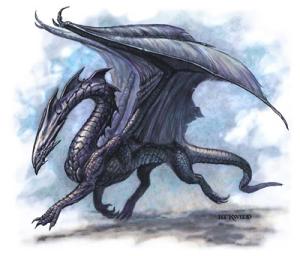
As Dungeons & Dragons is concerned, you can never have enough dragons. In addition to the ten standard variants, there are also several ones native to the Forgotten Realms, five of which are in this book. The Deep Dragon is one of the more interesting ones. I admit, I am very easily impressed by a good picture, and this Todd Lockwood illustration is awesome. Going with Wayne Reynolds as the main artist is one of the main things that makes 3.5e feel so noticably different from early 3rd edition. Deep dragons are cool. As the name implies, these dragons are native to the Underdark. While their wings imply that they were originally from the surface, their bodies are highly adapted to living in caves, being much more slender and thinner than most types of dragons. They are also of relatively small size, similar to black and white dragons. They are also natural shapechanger, which usually is found only in good dragons and not the evil ones. From a very young age they can turn into a snake, which allows them to navigate even very small passages, and a few years later they also develop the ability to take on the shape of any type of humanoid they wish. They are also very intelligent, even for dragons, which makes them very well suited for infiltrating any underground cities. If they make alliances with any of the Underdark races, it’s usually with the drow, as the two creatures have the most in common.
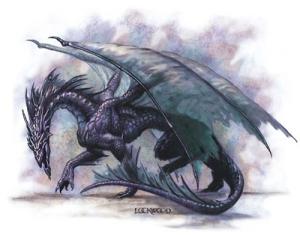
Shadow Dragons are a very unusual type of dragons and have some kind of very strong connection to the Shadow Plane. They are usually found in the Underdark and then commonly in the very most deepest region, far below the depths adventurers from the surface usually get to reach. They have a high degree of control over the darkness, allowing them to completely block all light around them or making themselves virtually invisible. Their breath weapon is particularly nasty and forces any creatures hit by it to make a rather tough saving throw or have several character levels drained. Fighting a an older shadow dragon without a death ward spell on everyone would be extremely difficult.
One of the other forms of dragons in the book is the Song Dragon, which you really could also just call a Harper Dragon. Because that’s what it is. It’s super charismatic, can transform into a beautiful human female, speaks every language, and is virtually impossible to detect as a dragon when in human form. And of course, they are completely devoted to helping people, protecting the land, and fighting evil, while hiding their true dragon nature. Don’t use Dragon Sue in your game, there is no way to do it in a way that won’t piss of your players. Fortunately people realized that and I am not aware of song dragons appearing anywhere outside this book.
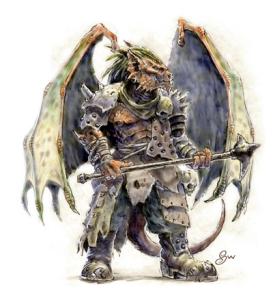
There isn’t much description about the Dragonkin, at least in this books, and they don’t really have any special ability other than flying. Many of them are allied with the Cult of the Dragon, an organization I believe was pretty important in 2nd edition, but never made any appearance in 3rd, as far as I am aware. The most interesting thing about them is that they very much strike me as proto-dragonborn, which became one of the player character races in 4th edition.
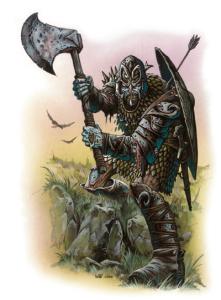
The Dread Warrior is a better kind of zombie, created by the Red Wizards of Thay. (Who else?) They are raised from fallen soldiers and retain some of their mind and abilities, making them more like ghouls. Not terribly creative, but ghouls with weapons and armor and some kind of military organization are pretty cool, I think. (Variant Ghoul +1)
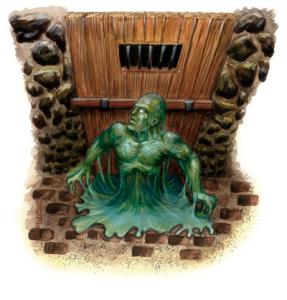
The Ghaunadan is a slime creature very much unlike any other in Dungeons & Dragons. In addition to being an ooze, it also is a shapechanger that can take the form of any kind of humanoid. It is also far from mindless like other oozes and instead a highly intelligent creature. It’s slime has a paralysis effect on living creatures and it also can easily disarm enemies by pulling their weapon into its body. A ghaunadan also has a limited form of charming gaze, which gives it a significant boost to all Charisma checks against a creature it has charmed, which makes ghaunadans excelent for infilitrating humanoid cities and palaces. Ghaunadans are associated with the ancient and evil god Ghaunaur, who rules over slimes and all kind of weird Underdark creatures and is sometimes worshiped by drow. Since all his traits are basically the same in every way as those of the demon lord Juiblex, I always consider them to be actually the same being. I don’t remember seing any hint of ghaunadans in any works older than this book, so it’s quite likely that they were inspired by the Shapechangers from Star Trek: Deep Space Nine, who are mostly the same thing but can also take the shape of objects and nonhumanoid creatures.
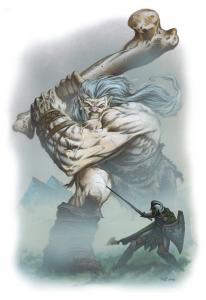
I can’t really say anything about the Fog Giant, other than it’s a giant without special abilities who ranks in power between a stone giant and a frost giant, but is taller than either. But look at this picture! When this guy hits you, you’re paste!
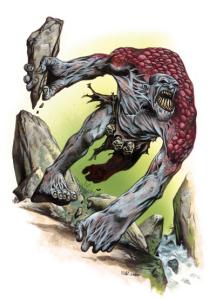
The Phaerlin Giant is a creature native to the Phaerlin region of the Underdark in the Forgotten Realms, which lies under the huge Anauroch desert and was once the location of the mighty wizard empire Netheril, but is under control of the phaerimms (more on those later). Phaerlin giants look like slightly mutated stone giants and live entirely underground, which I think is a neat idea. Reminds me of grimlocks. But their stats in this book are pretty wonkey. They are probably the only creature in D&D that is size category Huge and has a Challenge Rating of 3. Like any self respecting Underdark creature they have magic resistance and being primitive and feral they can sense nearby creatures by scent. Almost 70 hit points is also nothing to laugh at, but their backs are bent so badly that they move only very slowly. And for some unexplained, but nonmagical reason, they are so terrifying that characters who fight them have to make a saving throw or suffer penalties to all their attacks and saves because of fear. This is usually an ability reserved for the most powerful beasts and inhuman abominations. Here it just seems out of place. I like the cave giant from Pathfinder a lot more.
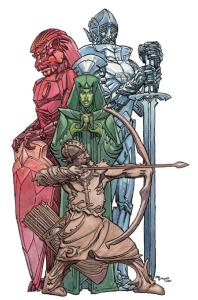
Usually I am not a fan of more types of golems, but the Gemstone Golems are a pretty cool idea. As golems go, they are not too terrifyingly powerful. But unlike other golems, the spirits that animate them are not forced to follow any order to the letter, which prevents them from any form of initative of creative planning, making them effectively mindless. Gemstone golems have more freedom, which makes them much more difficult to control, but also enables them to act and fight much more smarter. Unlike other golems, gemstone golems don’t have any really nasty trickes up their sleeves and attack simply by punching, but can be extremely difficult to damage. They don’t have a lot of hit points, but very high armor class and any weapon that is not heavily enchanted will just bounce off doing nothing. The ruby golem is the easiest to damage, but it also just regenerates almost all damage it takes. I’m not quite sure how players would even scratch these unless they know what needs to be done to damage them and also have the required (and very expensive) weapons at hand. I probably wouldn’t use these golems, but the idea of crystal golems that look like this is cool.
The Thayan Golem is a special kind of human sizes clay golem. It’s basically a terracotta archer. Unlike many other creatures in this book, the Challenge Rating for this one isn’t set too low, but much too high. This looks more like CR 4, not 8. As constructs it takes magic weapons to damage them, but it can also be done if you just hit them really hard. Their resistance to magic is also pretty low and not a huge problem. As seems tradition with this book, they have one completely random immunity, which is that they can not be harmed by the magic missile spell. I’m sure that will come up a lot in actual play. Obviously, these golems are made by the Red Wizards of Thay.
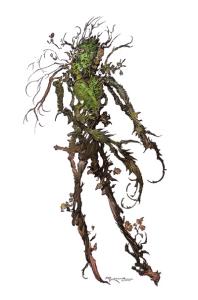
The Green Warder is a living plant, though I would probably make it a fey instead. But treants are also plants in D&D, so yeah. Green warders can be found in the great forest Cormanthor, where they used to be used as guardians by the elves of the great ancient city Myth Drannor. They are exceptionally well suited for that task, and given the great magical power of Myth Drannor, I wouldn’t be surprised if these creatures were created through magic. A green warder consists of leafy vines that are grown to roughly the shape of a tall elf and are relatively smart, though somewhat simple minded creatures. They are not very strong or tough and their claws do only little damage, but obviously they are extremely good at hiding themselves among plants. They also have some very useful magic abilities. They can use the sleep and confusion spells to neutralize intruders, but any time a creature successfully resists these it becomes increasingly more resistant against them for the rest of the day. So simply spamming these spells over and over until an intruder drops isn’t going to work. They also can set up alarm spells which create a loud birdcall whenever an intruder steps into the warded area, allerting the green warders and elven sentinels nearby. Green warders aren’t really dangerous, but as support troops for elven or other woodland armies they can be really effective additions.
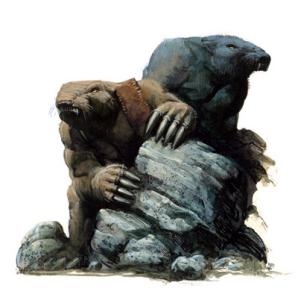
Groundlings are another magical creation, but this time not by the Red Wizards of Thay, but by the Zhentarim. While the Zhentarim are controlled by the priests of Bane, who create all those Bane creatures shown earlier, groundlings are created in the main stronghold of a rival faction within the Zhentarim. They are still the same gang, though. A groundling is a badgerlike creature created through magic from a dwarf. And I think the illustration does a good job of showing that relationship. Supposedly Zhentarim wizards create them to hunt down their enemies, but groundlings are not really very dangerous and I don’t see how they would be a useful resource for Zhentarim leaders, who have a lot more dangerous minions in their ranks. Still, I quite like the look and think there could be something interesting done with them. They are probably from some kind of adventure, where they have a bit more context.
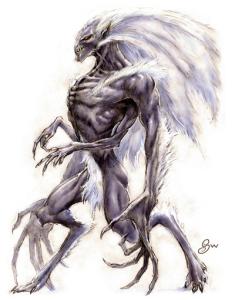
The Dreagloth is what The Tygre described as “the aftermath of a Black Metal album cover”. A draegloth is a specific type of half-demon created from a drow priestess of Lolth and a glabrezu demon (which is a 5 meter tall giant with four arms and a dog face). And it looks exactly as you’d expect it. A two and a half meter giant drow with four arms and a somehwat doglike face. A draegloth is violent and savage, but actually highly intelligent just like its parents, and gains most of the immunities from either side. I think they first appeared in the seventh or eighth Drizzt novel, but I hadn’t seen any picture of one until this one. And it absolutely kicks ass. A draegloth is like a blend of Wolverine and Blanka, just as pure and bloodthirsty incarnation of violence. I actually quite liked the War of the Spiderqueen novels and I think the draegloth Jeggred was one of the coolest characters. With the rest of the characters all being archwizards and high priestesses, they often underestimated him and dismissed him as stupid. But draegloths aren’t stupid or unaware of the finer details of intrigue that go on around them. They just don’t give a fuck about anything and exist only for carnage.
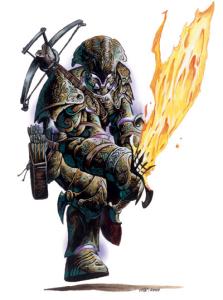
The Helmed Horror is probably one of my favorite monsters of my favorite monster book. I first saw these guys in Baldur’s Gate back in ’99, and they were terrifyingly strong. Good times. On first glance, the helmed horror is simply an animated suit of armor. But like many monsters in this book, it’s made into something much more interesting by giving it a small handful of magic abilities. Compared to true golems, it is relatively weak. But golems in Dungeons & Dragons are absolute terror beasts, so this guy is still amazingly dangerous. The main ability of a helmed horror is that it can make the blade of any weapon it holds burst into flame, covered in magic ice, or charged with lightining. It really only increases its damage by 1d6 points of damage, but it’s still an impressive looking effect that immediately tells everyone they mean business. They can also see any invisible creatures, which makes them great guardians for wizards. In addition to being made of full plate armor and difficult to hit, they are also have all the immunities of constructs and are enchanted to be completely immune to three specific spells. Usually those will be classic attack spells like fireball or lightning bolt, and while casting a spell that affects everything in a large area on a single enemy is not particularly effective, there aren’t that many other spells that can really hurt helmed horrors to begin with. As constructs, they are already immune to almost all illusions, enchantments, and necromancy spells. Disabling a helmed horror other than by hacking it to pieces is quite the challenge. Fot added fun, it also has the spells air walk and feather fall, which make it almost impossible to use the terrain against it. Pits and barriers won’t stop it at all, and even though being a heavy suit of armor, a helmed horror is just as fast as any ordinary human. It’s a fucking Terminator.
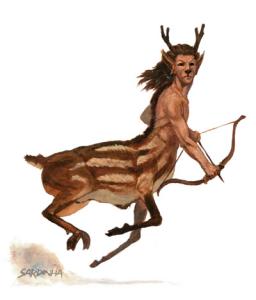
The Hybsil is one of the rare fey creatures in D&D 3rd edition, which for some reason never got much love beond the dryad, nymph, pixie, and satyr. Hybsils look like a small deer with the upper body of a small human or halfling with short antlers on their head. Though individually they are quite weak and vulnerable, they usually live in groups of several dozens and their high speed combined with their reliance on bows and arrows can make them formidable opponents. They also have the magical abilities to move without leaving any tracks and to greatly increase the distance of their jumps, which makes them amazingly well suited for ambushs. For emergencies, they also have a few magical sleep arrows they get from pixies, which can knock out many enemies instantly. They are also lead by druids and have their own rangers and sorcerers, which makes things a lot more complicated for any potential attackers. Picking a fight with any hybsils in their forest homes is much more dangerous than it looks from seeing just one or two of these small creatures.
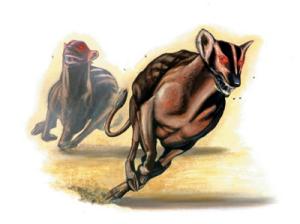
The Leucrotta is a dangerous predator based on sketchy descriptions of hyenas by the Romans. This creature simply runs with it and is exactly what was described. It has the body of an antelope, the tail of a lion, and the head of a badger, It is as large as a horse and has jaws that can even bite through armor. Leucrottas are intelligent creature and completely evil and violent. They simply live for killing. Quite surprisingly to many people, they also can talk and are very capable of immitating the voice of other animals and even people. These guys are some really viscious murder machines and that they are very able at climbing and jumping doesn’t make things better for anyone.
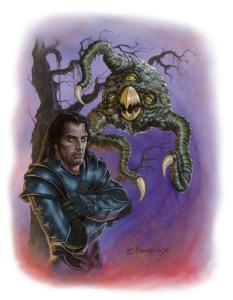
The Malaugrym are a race of alien shapeshifters from another dimension who travel through the shadow plane to reach the world of Toril. They resemble in some way both beholders and grells, but are almost always encountered in the guise of a human or other humanoid creature. However, if they want to they can take the shape of pretty much anything. Other than that they have no really remarkable abilities, but are often high level wizards or rogues. To be frank, their description here sucks. These are clearly enemies from some novel, who probably have a complex and interesting background, but the creature presented here really is just a shapechanger that can change into anything.
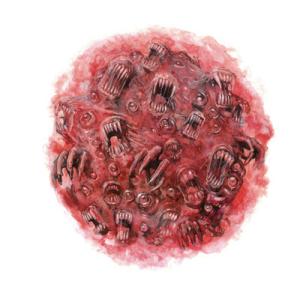
A Nishruu is a mistlike creature that feeds on magic. While intelligent, they do not talk and can not be mentally controlled in any way. Any spell targeted at them has no effect and simply makes them grow larger and when it is in contact with magic items it drains or temporarily disables them. When they come into contact with a spellcaster, the spellcaster loses prepared spells ever round. The only thing that can really hurt them are fire and cold spells, which it can not absorb. The idea is quite interesting, but fighting them is probably going to get very frustrating for players. Slaying one would likely require a small expedition and trying lots of different methods, but I don’t see how they could slay one as a regular wandering monster in a dungeon if they don’t already know what can kill it. Still, as the centerpiece of an adventure a nishruu might be a pretty interesting opponent.
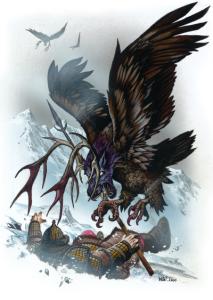
The Peryton is one of the truly bizarre creatures in D&D, and it won’t be a surprise to anyone that it originally appeared in the Fiend Folio (though with all the weird stuff in that book, it doesn’t really stand out much). I think it’s actually a creature from Greek myth, and a hyper-violent intelligent bird monster seems just the kind of critter they would love. Fits right next to harpies, sirens, and erinyes. A peryton is a large eagle with the head of a wolf and the antlers of a stag. It hates everything and only wants to kill and take the heart from its victims. It’s not particularly interesting, but probably can make for a nice addition to any adventure.
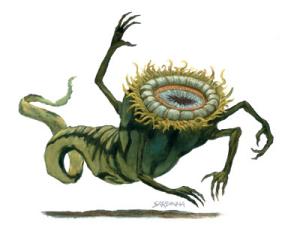
The Phaerimm are the Forgotten Realms reply to the Greyhawk weirdness that is beholders, mind flayers, and aboleths. These huge flying worms not only look bizarre, they are also extremely intelligent and powerful sorcerers. They appeared way back in the book FR13: Anauroch, but only became really relevant in late 2nd edition. They are the ancient enemy that destroyed the wizard empire Netheril by turning its land into the Anauroch desert, forcing the Netherese to flee to all corners of the world. While the Netherese were a pretty big deal, I wouldn’t be surprises if many Forgotten Realms fans have never heard of them. Native to the Underdark, they are a race of evil overlords who even enslave mind flayers and beholders within their domain. Fortunately, one of their enemies created a magical barrier that trapped the phaerimm in a large section of the Underdark, which know about matches the area of the Anauroch desert on the surface above.
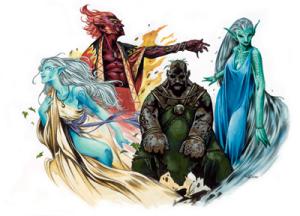
Like tieflings and aasimar, Genasi are humanoids who are descended from magical creatures from other worlds. Instead of demons or angels, the ancestors of genasi are usually genies or other somewhat humanoid elemental creatures. Genasi first appeared in the Planescape book Planewalker’s Handbook, but to my knowledge the setting never really did much with them. I think probably because it focused much more on the dozens of heavens and hells, while the elemental planes always played a relatively minor role. For reasons completely unknown to me, genasi were picked up a few years later in the Forgotten Realms campaign setting book for 3rd edition, even though they didn’t really have any role in this setting before. While they never were huge, genasi really were mostly Forgotten Realms creatures in 3rd edition, but got even more appearances in 4th. There really isn’t much to say about them. They have a small bonus to one ability score which is compensated by an equal penalty to another score, and they get a laughable tiny bonus to resist spells of their element and a single spell they can cast one per day. Crunch-wise they completely suck, but I really love the idea of people who have the blood of spirits in their ancestry which comes from the elements instead from angels or demons. And while the illustration in this book is pretty bad, there are plenty of really great ones in other books.
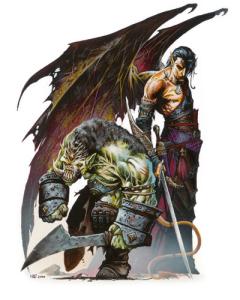
The book also has two unique types of tieflings. The Fey’ri and the Tanarruk. Both are connected to the fortress Hellgate Keep, which makes me strongly suspect that they are from the same adventure or novel. The Fey’ri are the descendants of an ancient elven family that tried to increase the magical strength of their bloodline by interbreeding with succubuses. It worked, and the first generations resulted in half-fiend elves, with their later offspring being fey’ri tieflings. Eventually the demonic elves where discovered and mostly destroyed, but a few survived and disappeared for centuries. And now they are back. Fey’ri mostly have the abilities of both elves and tieflings, but also can change their shape to appear like normal elves and have a few additional magic powers, which vary by individual. I personally really like these guys. Evil demonic elves! I can’t really defend my position here, because every single element seems totally cliched and overdone. But they don’t only work as substitute emo-vampires, but also as really cool decadent Sword & Sorcery warlocks.
The tanarruk are creations of the demon rulers of Hellgate Keep, who bred them from lesser demons and orcs. Despite their much more savage look, they are actually smarter than normal orcs and a lot tougher. As a nasty surprise, they have a very high resistance against fire and also some immunity to magic, which makes them really well suited as shock troopers to charge at enemy wizards.
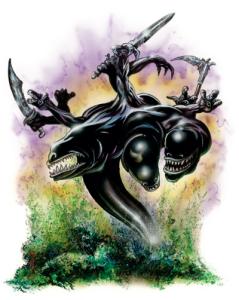
The phaerimm were weird, but the Sharn are even weirder. They are large black creatures with three eyeless heads and three arms that each end in three hands with three fingers and an eye in each palm. Like that phaerimm, they are powerful sorcerers but also clerics and they can create three small portals through which they can stick their hands to cast spells at targets behind walls, around corners, or similar situations. To make things worse, sharn are always under the effect of the haste spell, which under the rules version of this book allows them to cast two spells every round. Not surprisingly, these creatures are so alien that they are immune to any magic that manipulates their minds or changes their bodies. A somewhat unusual quirk is that no magic can change the shape of another creature to look like a sharn. Why that is the case seems to be simply an oddity of the universe. While the sharn are both very weird and alien, they are thankfully not really evil and they also hate the phaerimm. In fact it was the sharn who created the magical barrier that trapped the phaerimm under the Anauroch desert. These guys are some really trippy stuff. They first appeared with the phaerimm in the sourcebook Anauroch, which I didn’t know was actually written by Ed Greenwood himself. It’s strange that they have such a tiny presence in the Forgotten Realms. I only ever saw them in this monster book and the Return of the Archwizards novels, which are about the return of the Netherese Empire from the Plane of Shadow, which got the phaerimm all rilled up.
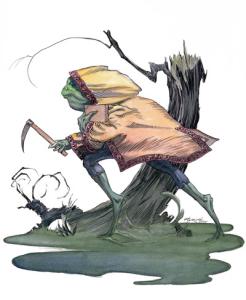
The Sivs are a race of frog people similar to the classic bullywugs, but also very different. While bullywugs are primitive savages, the sivs are as smart as humans and usually Lawful Evil, and even have training as monks. I’m not sure if there’s a kung-fu toad style. They also have the ability to run on the surface of water, which is very kung-fu indeed. It all looks like a quite intriguing idea, but sadly there isn’t really any useful description to how they behave and what they want.
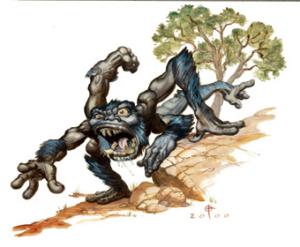
The Tall Mouther is classic old-school D&D weirdness. It’s a big head with a big maw and six arms, covered in blue fur. Otherwise it’s a bit like an ogre and especially loves to eat halflings.
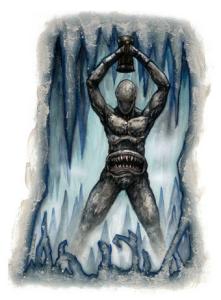
The Tomb Tapper is one of the more mysterious creatures of the Forgotten Realms. They are huge golems that resemble humans, but have no face. Instead their large mouth is in the center of their stomach and they don’t have any eyes at all. Tomb Tappers only exist to search for and collect magic items. They are usually found deep underground where they are digging into ancient tombs and subterranean ruins. Not only are they incredibly strong and very smart, they are also almost impossible to hurt with all but the most strongly enchanted weapons and can sense their environment perfectly in total darkness. They were originally created by the wizards of Netheril to fight against the phaerimm and destroying nonhumanoid spellcasters (including mind flayers, aboleths, and so on) is the one thing that has a higher priority for them than collecting magic treasures. Rumor has it that the tomb tapper take all the magic items they find to a single location deep below the Anauroch desert, which very well might be the greatest treasure hord and collection of magic in the whole world.
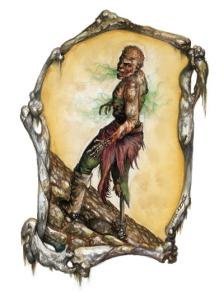
Remember all the Bane monsters at the start of this book? Here’s more! The former high priest of Bane and later high priest of Banes son Xvim created the Tyrantfog Zombies as a means to destroy the rival clerics of the new god Cyric, many of which had been priests of Bane before. Once touched by a strange green fog, they would fall ill and die. Then they would rise as zombielike undead that continue to spread the magical fog through the world. Thankfully the fog that flows from their mouths and holes in their rotting bodies does not have the power to create more tyrantfog zombies but only drains the strength from living creatures that get too close to them. When injured by the claws of the tyrantfog zombie, they spread a terrible disease that can permanently cripple anyone who gets infected, even if they survive it.
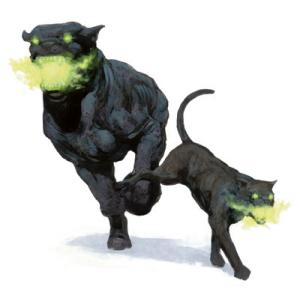
The Beasts of Xvim are another creation of Xvims high priest. They are normal animals that get magically transformed to get bigger, stronger, and utterly evil. They are always black with green glowing eyes and glowing green mist coming from their mouths. Once created, these beasts have to kill living people and devour their souls.
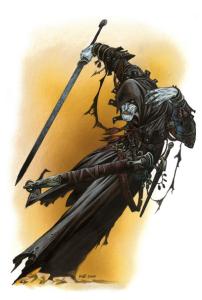
The Cursts are once mortal warriors who had been killed by the forces of the death god Myrkul while inside zones of wild magic douring the Time of Troubles, when the gods of the Forgotten Realms walked the world in physical for and spread lots of chaos and destruction. The curst are undead and somewhat insane, and also almost impossible to destroy. As long as the head remains, the rest of the body can magically grow back. They are not evil, but their insanity still makes them a serious threat.
Monsters of Faerûn Cliche Creature Counter:
- Evil Apes: 0
- Variant Ghouls: 3
- Demon Dogs: 1
- Skeletons with Robes: 0
